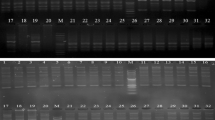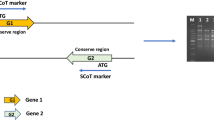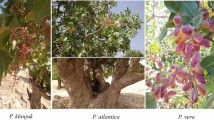Abstract
Being an economical and nutritional crop, Capsicum appeases people’s peppery taste and is found to be widely distributed all over the world having vast diversity. In the present study, genetic polymorphism, cross transferability (CT) and genetic diversity were examined among the 54 different accessions of Capsicum species including 49 of Capsicum annuum, three of C. baccatum and two of C. frutescens, using a set of 36 start codon targeted (SCoT) primers. Of the total, 35 SCoT markers showed successful amplification profile among chilli germplasms and an average primer polymorphism was reported as 81.52% which ranged from 50% (SCoT-6) to 100% (SCoT-11). A total of 365 amplicons were obtained with an average of 10.43 bands per primer and the length of the bands ranged from 150 bp to 1.2 kb. Further, polymorphic information content value of SCoT markers ranged from 0.42 (for SCoT-25) to 0.86 (SCoT-27) with an average of 0.78. The average value of CT of SCoT markers was 44.08% ranged from 14.25% to 57.26% among different chilli accessions. A dendrogram was constructed and established genetic relationship among 54 capsicum species, with the help of translation initiation codon polymorphisms or SCoT primer amplification. This study suggests the effectiveness of SCoT marker system for characterizing and assessing genetic diversity of Capsicum germplasm, which can be used for evolutionary studies and to identify agronomically important traits.





Similar content being viewed by others
References
Agarwal M., Shrivastava N. and Padh H. 2008 Advances in molecular marker techniques and their applications in plant sciences. Plant Cell Rep. 27, 617–631.
Agarwal A., Gupta V., Haq S. U., Jatav P. K., Kothari S. and Kachhwaha S. 2018 Assessment of genetic diversity in 29 rose germplasms using SCoT marker. J. King Saud Univ.-Sci. (https://doi.org/10.1016/j.jksus.2018.04022).
Aguilar-Meléndez A., Morrell P. L., Roose M. L. and Kim S. C. 2009 Genetic diversity and structure in semiwild and domesticated chillies (Capsicum annuum; Solanaceae) from Mexico. Am. J. Bot. 96, 1190–1202.
Akyavuz R., Taskin B., Koçak M. and Yildiz M. 2018 Exploring the genetic variations and population structure of Turkish pepper (Capsicum annuum L.) genotypes based on peroxidase gene markers. 3. Biotech. 8, 355.
Al-Qurainy F., Khan S., Nadeem M. and Tarroum M. 2015 SCoT marker for the assessment of genetic diversity in Saudi Arabian date palm cultivars. Pak. J. Bot. 47, 637–643.
Amirmoradi B., Talebi R. and Karami E. 2012 Comparison of genetic variation and differentiation among annual Cicer species using start codon targeted (SCoT polymorphism, DAMD-PCR, and ISSR markers. Plant Syst. Evol. 298, 1679–1688.
Andersen J. R. and Lübberstedt T. 2003 Functional markers in plants. Trends Plant Sci. 8, 554–560.
Arumuganathan K. and Earle E. 1991 Nuclear DNA content of some important plant species. Plant Mol. Biol. Rep. 9, 208–218.
Bhattacharyya P., Kumaria S., Kumar S. and Tandon P. 2013 Start codon targeted (SCoT) marker reveals genetic diversity of Dendrobium nobile Lindl., an endangered medicinal orchid species. Gene 529, 21–26.
Botstein D., White R. L., Skolnick M. and Davis R. W. 1980 Construction of a genetic linkage map in man using restriction fragment length polymorphisms. Am. J. Hum. Genet. 32, 314.
Bramley P. M. 2000 Is lycopene beneficial to human health?Phytochemistry 54, 233–236.
Cardoso R., Ruas C. F., Giacomin R. M., Ruas P. M., Ruas E. A., Barbieri R. L. et al. 2018 Genetic variability in Brazilian Capsicum baccatum germplasm collection assessed by morphological fruit traits and AFLP markers. PloS One 13, e0196468.
Chen C., Durand E., Forbes F. and François O. 2007 Bayesian clustering algorithms ascertaining spatial population structure, a new computer program and a comparison study. Mol. Ecol. Notes 7, 747–756.
Chen H., He X., Luo C., Zhu J. and Li F. 2010 Analysis on the genetic diversity of 24 longan (Dimocarpus longan) accessions by SCoT markers. Acta Hort. Sin. 37, 1651–1654.
Collard B., Jahufer M., Brouwer J. and Pang E. 2005 An introduction to markers, quantitative trait loci (QTL) mapping and marker-assisted selection for crop improvement, the basic concepts. Euphytica 142, 169–196.
Collard B. C. and Mackill D. J. 2009 Start codon targeted (SCoT) polymorphism, a simple, novel DNA marker technique for generating gene-targeted markers in plants. Plant Mol. Biol. Rep. 27, 86.
Csilléry G. 2006 Pepper taxonomy and the botanical description of the species. Acta Agron. Hung. 54, 151–166.
Dagnoko S., Yaro-Diarisso N., Sanogo P. N., Adetula O., Dolo-Nantoumé A., Gamby-Touré K. et al. 2013 Overview of pepper (Capsicum spp.) breeding in West Africa. Afr. J. Agric. Res. 8, 1108–1114.
Deng L., Liang Q., He X., Luo C., Chen H. and Qin Z. 2015 Investigation and analysis of genetic diversity of diospyros germplasms using SCoT molecular markers in Guangxi. PloS One 10, e0136510.
Dhaliwal M., Yadav A. and Jindal S. 2014 Molecular characterization and diversity analysis in chilli pepper using simple sequence repeats (SSR) markers. Afr. J. Biotechnol. 13, 3137–3143.
Djian-Caporalino C., Lefebvre V., Sage-Daubèze A. and Palloix A. 2007 Capsicum, genetic resources, chromosome engineering, and crop improvement, CRC Press, Boca Raton, pp. 185–243.
Doyle J. J. 1990 Isolation of plant DNA from fresh tissue. Focus 12, 13–15.
Evanno G., Regnaut S. and Goudet J. 2005 Detecting the number of clusters of individuals using the software structure, a simulation study. Mol. Ecol. 14, 2611–2620.
Falush D., Stephens M. and Pritchard J. K. 2003 Inference of population structure using multilocus genotype data, linked loci and correlated allele frequencies. Genetics 164, 1567–1587.
Farooq S. and Azam F. 2002 Molecular markers in plant breeding-II. Some pre-requisites for use. Pak. J. Biol. Sci. 5, 1141–1147.
Feng S., He R., Yang S., Chen Z., Jiang M., Lu J. et al. 2015 Start codon targeted (SCoT) and target region amplification polymorphism (TRAP) for evaluating the genetic relationship of Dendrobium species. Gene 567, 182–188.
Gaikwad A. B., Archak S. and Gautam D. 2013 DNA profiling of Capsicum annuum L. Cultivars based on AFLP and ISSR markers. Geneconserve 12, 4–12.
González-Pérez S., Garcés-Claver A., Mallor C., de MieraL. E. S., Fayos O., Pomar F. et al. 2014 New insights into Capsicum spp relatedness and the diversification process of Capsicum annuum in Spain. PloS One 9, e116276.
Gorji A. M., Poczai P., Polgar Z. and Taller J. 2011 Efficiency of arbitrarily amplified dominant markers (SCoT, ISSR and RAPD) for diagnostic fingerprinting in tetraploid potato. Am. J. Potato. Res. 88, 226–237.
Guerra M. 2008 Chromosome numbers in plant cytotaxonomy, concepts and implications. Cytogenet. Genome Res. 120, 339–350.
Gulsen O., Sever-Mutlu S., Mutlu N., Tuna M., Karaguzel O., Shearman R. C. et al. 2009 Polyploidy creates higher diversity among Cynodon accessions as assessed by molecular markers. Theor. Appl. Genet. 118, 1309–1319.
Guo D.-L., Zhang J.-Y. and Liu C.-H. 2012 Genetic diversity in some grape varieties revealed by SCoT analyses. Mol. Biol. Rep. 39, 5307–5313.
Gupta P. and Rustgi S. 2004 Molecular markers from the transcribed/expressed region of the genome in higher plants. Funct. Integr. Genomics 4, 139–162.
Haq S., Jain R., Sharma M., Kachhwaha S. and Kothari S. 2014 Identification and characterization of microsatellites in expressed sequence tags and their cross transferability in different plants. Intl. J. Genomics 2014, 863948, 12 pages.
Hill T. A., Ashrafi H., Reyes-Chin-Wo S., Yao J., Stoffel K., Truco M.-J. et al. 2013 Characterization of Capsicum annuum genetic diversity and population structure based on parallel polymorphism discovery with a 30K unigene pepper GeneChip. PloS One 8, e56200.
Kim S., Park M., Yeom S.-I., Kim Y.-M., Lee J. M., Lee H.-A. et al. 2014 Genome sequence of the hot pepper provides insights into the evolution of pungency in Capsicum species. Nat. Genet. 46, 270.
Knapp S., Bohs L., Nee M. and Spooner D. M. 2004 Solanaceae – a model for linking genomics with biodiversity. Int. J. Genomics 5, 285–291.
Kothari S., Joshi A., Kachhwaha S. and Ochoa-Alejo N. 2010 Chilli peppers – a review on tissue culture and transgenesis. Biotechnol. Adv. 28, 35–48.
Luo C., He X.-H., Chen H., Ou S.-J. and Gao M.-P. 2010 Analysis of diversity and relationships among mango cultivars using start codon targeted (SCoT) markers. Biochem. Syst. Ecol. 38, 1176–1184.
Luo C., He X.-H., Chen H., Hu Y. and Ou S.-J. 2012 Genetic relationship and diversity of Mangifera indica L., revealed through SCoT analysis. Genet. Resour. Crop. Evol. 59, 1505–1515.
Makari H., Patil H. R., Abhilash M. and Kumar H. M. 2009 Genetic diversity in commercial varieties of chilli as revealed by RAPD method. Indian J. Sci. Technol. 2, 91–94.
Misra S., Lal R. K., Darokar M. P. and Khanuja S. P. S. 2011 Genetic variability in germplasm accessions of Capsicum annuum L. Am. J. Plant Sci. 2, 629.
Monna L., Miyao A., Inoue T., Fukuoka S., Yamazaki M., Zhong H. S. et al. 1994 Determination of RAPD markers in rice and their conversion into sequence tagged sites (STSs) and STS-specific primers. DNA Res. 1, 139–148.
Moscone E. A., Baranyi M., Ebert I., Greilhuber J., Ehrendorfer F. and Hunziker A. T. 2003 Analysis of nuclear DNA content in Capsicum (Solanaceae) by flow cytometry and Feulgen densitometry. Ann. Bot. 92, 21–29.
Mulpuri S., Muddanuru T. and Francis G. 2013 Start codon targeted (SCoT) polymorphism in toxic and non-toxic accessions of Jatropha curcas L. and development of a codominant SCAR marker. Plant Sci. 207, 117–127.
Nath V. S., Hegde V. M., Jeeva M. L., Misra R. S., Veena S. S., Raj M. et al. 2015 Genetic diversity of Phytophthora colocasiae causing taro leaf blight, analysis using start codon targeted (SCoT) polymorphism. J. Root Crops 39, 168–177.
Navarro J. M., Flores P., Garrido C. and Martinez V. 2006 Changes in the contents of antioxidant compounds in pepper fruits at different ripening stages, as affected by salinity. Food Chem. 96, 66–73.
Page R. 1996 TREEVIEW, An application to display phylogenetic trees on personal computers. Comput. Appl. Biosci. 12, 357–358.
Paran I. and Michelmore R. 1993 Development of reliable PCR-based markers linked to downy mildew resistance genes in lettuce. Theor. Appl. Genet. 85, 985–993.
Paran I., Aftergoot E. and Shifriss C. 1998 Variation in Capsicum annuum revealed by RAPD and AFLP markers. Euphytica 99, 167–173.
Pavlicek A., Hrda S. and Flegr J. 1999 Free-tree–freeware program for construction of phylogenetic trees on the basis of distance data and bootstrap/jackknife analysis of the tree robustness. Application in the RAPD analysis of genus Frenkelia. Folia. Biol. (Krakow) 45, 97.
Pickersgill B. 1977a Chromosomes and evolution in Capsicum. In: E. Pochard (Ed). Capsicum 77, C.R. 36me Congres EU- CARPIA Piment, INRA, Avignon-Montfavet.
Pickersgill B. 1997b Genetic resources and breeding of Capsicum spp. Euphytica 96, 129–133.
Portis E., Nagy I., Sasvari Z., Stagel A., Barchi L. and Lanteri S. 2007 The design of Capsicum spp. SSR assays via analysis of in silico DNA sequence, and their potential utility for genetic mapping. Plant Sci. 172, 640–648.
Pritchard J. K., Stephens M. and Donnelly P. 2000 Inference of population structure using multilocus genotype data. Genet. 155, 945–959.
Purkayastha J., Alam S., Gogoi H. and Singh L. 2012 Capsicum assamicum sp. nov. (Solanaceae), from Assam, northeastern India. Ozean J. Appl. Sci. 5, 55–66.
Rai V. P., Kumar R., Kumar S., Rai A., Kumar S., Singh M. et al. 2013 Genetic diversity in Capsicum germplasm based on microsatellite and random amplified microsatellite polymorphism markers. Physiol. Mol. Biol. Plants 19, 575–586.
Rathore N. S., Rai M. K., Phulwaria M., Rathore N. and Shekhawat N. 2014 Genetic stability in micropropagated Cleome gynandra revealed by SCoT analysis. Acta. Physiol. Plant. 36, 555–559.
Rodriguez J., Berke T., Engle L. and Nienhuis J. 1999 Variation among and within Capsicum species revealed by RAPD markers. Theor. Appl. Genet. 99, 147–156.
Sambrook J. and Russell D. W. 2001 Molecular cloning, A laboratory manual. 2001, Cold Spring Harbor Laboratory Press, Cold Spring Harbor, New York.
Satya P., Karan M., Jana S., Mitra S., Sharma A., Karmakar P. et al. 2015 Start codon targeted (Scot) polymorphism reveals genetic diversity in wild and domesticated populations of ramie (Boehmeria nivea L. Gaudich.), a premium textile fiber producing species. Meta. Gene. 3, 62–70.
Slattery M. L., Benson J., Curtin K., Ma K.-N., Schaeffer D. and Potter J. D. 2000 Carotenoids and colon cancer. Am. J. Clin. Nutr. 71, 575–582.
Smith J., Chin E., Shu H., Smith O., Wall S., Senior M. et al. 1997 An evaluation of the utility of SSR loci as molecular markers in maize (Zea mays L.), comparisons with data from RFLPs and pedigree. Theor. Appl. Genet. 95, 163–173.
Taranto F., D’Agostino N., Greco B., Cardi T. and Tripodi P. 2016 Genome-wide SNP discovery and population structure analysis in pepper (Capsicum annuum) using genotyping by sequencing. BMC Genomics 17, 943.
Thul S., Lal R., Shasany A., Darokar M., Gupta A., Gupta M. et al. 2009 Estimation of phenotypic divergence in a collection of Capsicum species for yield-related traits. Euphytica 168, 189–196.
Toquica S. P., Rodríguez F., Martínez E., Duque M. C. and Tohme J. 2003 Molecular characterization by AFLPs of Capsicum germplasm from the Amazon department in Colombia. Genet. Resour. Crop Evol. 50, 639–647.
USDA-ARS 2011 Grin species records of Capsicum. National 2063 Germplasm Resources Laboratory, Beltsville, Maryland.
Votava E. J., Nabhan G. P. and Bosland P. W. 2002 Genetic diversity and similarity revealed via molecular analysis among and within an in situ population and ex situ accessions of chiltepin (Capsicum annuum var. glabriusculum). Conserv. Genet. 3, 123–129.
Votava E. J., Baral J. B. and Bosland P. W. 2005 Genetic diversity of Chile (Capsicum annuum var. annuum L.) landraces from northern New Mexico, Colorado, and Mexico. Econ. Bot. 59, 8–17.
Wu J.-M., Li Y.-R., Yang L.-T., Fang F.-X., Song H.-z., Tang H.-Q. et al. 2013 cDNA-Scot, a novel rapid method for analysis of gene differential expression in sugarcane and other plants. Aust. J. Crop Sci. 7, 659.
Xiong F., Zhong R., Han Z., Jiang J., He L., Zhuang W. et al. 2011 Start codon targeted polymorphism for evaluation of functional genetic variation and relationships in cultivated peanut (Arachis hypogaea L.) genotypes. Mol. Biol. Rep. 38, 3487–3494.
Yatung T., Dubey R. K., Singh V. and Upadhyay G. 2014 Genetic diversity of chilli (‘Capsicum annuum’ l.) genotypes of India based on morpho-chemical traits. Aust. J. Crop Sci. 8, 97.
Zeng B., Zhang Y., Huang L., Jiang X., Luo D. and Yin G. 2014 Genetic diversity of orchardgrass (Dactylis glomerata L.) germplasms with resistance to rust diseases revealed by start codontargeted (SCoT) markers. Biochem. Syst. Ecol. 54, 96–102.
Acknowledgements
The authors express sincere thanks to Council of Scientific and Industrial Research (CSIR) and Indian Council of Medical Research (ICMR) for providing Junior Research Fellow (JRF). We are also grateful to UGC-UPE programme and Bioinformatics Infrastructure Facilities (BIF), University of Rajasthan for providing research facilities. CSIR-Research Associate programme is also acknowledged for providing fellowship. Our thanks are extended to Ms Raini Verma, Ms Prerna Dhingra and Ms Rakhi Poonia for their assistance in technical work.
Author information
Authors and Affiliations
Corresponding author
Additional information
Corresponding Editor: Qingpo Liu
Rights and permissions
About this article
Cite this article
Gupta, V., Jatav, P.K., Haq, S.U. et al. Translation initiation codon (ATG) or SCoT markers-based polymorphism study within and across various Capsicum accessions: insight from their amplification, cross-transferability and genetic diversity. J Genet 98, 61 (2019). https://doi.org/10.1007/s12041-019-1095-0
Received:
Revised:
Accepted:
Published:
DOI: https://doi.org/10.1007/s12041-019-1095-0




